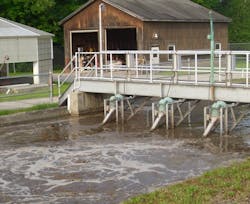More than two decades ago, cold Vermont winters brought the Fair Haven Wastewater Treatment Facility to a halt with brush rotor icing problems. A major upgrade that included the Aire-O2 aspirator aeration system not only ended the wintertime blues but helped the municipality gain the flexibility to maintain high-quality effluent under changing conditions and regulations, creating a model for a successful, sustainable facility.
The Fair Haven municipality is located close to the southern tip of Lake Champlain in Rutland County in west-central Vermont. From 1969 to 1989, the wastewater treatment facility consisted of a racetrack oxidation ditch, and a set of brush rotors provided aeration.
Peter Laramie is the chief operator at the Fair Haven Wastewater Treatment Facility. He has been associated with the plant as far back as 1985. “During our cold Vermont winters, ice covered everything in the vicinity of the rotors,” Laramie said. “When a real problem developed, we could go without any aeration for a week or more.”
Besides the excessive downtime, it required heavy equipment to remove and re-install the rotors, resulting in costly maintenance.
A major upgrade was planned for the treatment facility in 1989, which specified brush rotors. But after seeing literature about the Aire-O2 aspirator aeration system, the staff was convinced the aspirator aerators were a better product solution for their application and urged the town’s engineers to include them in the design.
Six Aire-O2 aspirator aerators manufactured by Aeration Industries of Chaska, Minn., were installed on bridge mounts in the ditch. Each aerator is equipped with a motor that delivers 15 hp at 1800 rotations per minute (rpm). “Maintenance on these aerators takes only one-sixth of our aeration capacity out of service at any one time,“ Laramie said. “A unit can be repaired in a few hours or less by two people without requiring any heavy equipment.”
Today, the Fair Haven Wastewater Treatment Facility’s staff has finely tuned and evolved the plant to conform to changing flows, permits and challenging treatment issues. Control of the aeration units also has evolved over the years to make the process more efficient and effective.
The current population of the community is 2,800. The treatment plant’s average influent flow rate is 0.35 million gal per day (mgd) but may be as high as 0.9 mgd in the spring due to snow melt run-off. The influent BOD is 160 mg/L and TSS is 160 mg/L.
Pretreatment consists of a manual bar rack followed by a settling basin with a cyclone grit separator and comminutor, installed during the 1989 upgrade. Next, the wastewater flows through anoxic selector tanks, an upgrade made in 2000. Originally a series of three selector tanks, the third tank was converted to an aeration tank in which a mechanical aerator was installed in 2009.
Aeration in the racetrack oxidation ditch built in 1969 was upgraded with timers in 2006 and VFDs in 2007 and also was linked to a dissolved oxygen meter, first in 1996 and again in 2005. Aeration is still provided by the same six 15-hp Aire-O2 aerators. Timed operation of the aerators allows the plant to achieve both nitrification and denitrification.
Mixed liquor flows by gravity from the oxidation ditches to two circular clarifiers. Return-activated sludge (RAS) is pumped from the clarifiers to the first selector tank. Waste-activated sludge (WAS) is pumped to a circular aerobic digester, originally a clarifier, that was converted in 1989.
Secondary effluent flows by gravity from the circular clarifiers to a chlorine contact tank where sodium hypochlorite is added for disinfection, followed by the addition of sodium bisulfate for dechlorination. The final effluent is discharged to the Castleton River near the mouth of Lake Champlain.
The final effluent quality from the plant is excellent, with BOD at 3 mg/L, TSS at 2 mg/L and ammonia at 1 mg/L.
“The effectiveness and flexibility of the Aire-O2 units has been instrumental in allowing us to maintain a high quality effluent under diverse conditions where daily flows and air temperatures vary extremely during the year,” Laramie said.
Winter is no longer a problem in Vermont for the Fair Haven plant. “The Aire-O2 aerators put air into the wastewater and not the other way around, ending our wintertime icing problems,” Laramie said.
With many municipalities across the nation struggling with treatment challenges associated with escalating state and federal regulatory requirements coupled with tighter budgets, the Fair Haven Wastewater Treatment Facility is a model of staying ahead of tomorrow’s technological demands.


